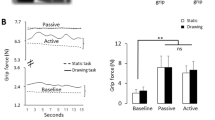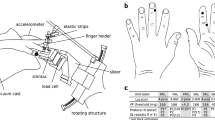Abstract
Unexpected pulling and pushing loads exerted by an object held with a precision grip evoke automatic and graded increases in the grip force (normal to the grip surfaces) that prevent escape of the object; unloading elicits a decrease in grip force. Anesthesia of the digital nerves has shown that these grip reactions depend on sensory signals from the digits. In the present study we assessed the capacity of tactile afferents from the digits to trigger and scale the evoked grip responses. Using tungsten microelectrodes inserted percutaneously into the median nerve of awake human subjects, unitary recordings were made from ten FA I and 13 FA II rapidly adapting afferents, and 12 SA I and 18 SA II slowly adapting afferents. While the subject held a manipulandum between a finger and the thumb, tangential load forces were applied to the receptor-bearing digit (index, middle, or ring finger or thumb) as trapezoidal load-force profiles with a plateau amplitude of 0.5 – 2.0 N and rates of loading and unloading at 2 – 8 N/s, or as “step-loads” of 0.5 N delivered at 32 N/s. Such load trials were delivered in both the distal (pulling) and proximal (pushing) direction. FA I afferents responded consistently to the load forces, being recruited during the loading and unloading phases. During the loading ramp the ensemble discharge of the FA I afferents reflected the first time-derivative of the load force (i.e., the load-force rate). These afferents were relatively insensitive to the subject's grip force responses. However, high static finger forces appeared to suppress excitation of these afferents during the unloading phase. The FA II afferents were largely insensitive to the load trials: only with the step-loads did some afferents respond. Both classes of SA afferents were sensitive to load force and grip force, and discharge rates were graded by the rate of loading. The firing of the SA I afferents appeared to be relatively more influenced by the subject's grip-force response than the discharge of the SA II afferents, which were more influenced by the load-force stimulus. The direction in which the tangential load force was applied to the skin influenced the firing of most afferents and in particular the SA II afferents. Individual afferents within each class (except for the FA IIs) responded to the loading ramp before the onset of the subject's grip response and may thus be responsible for initiating the automatic increase in grip force. However, nearly half of the FA I afferents recruited by the load trials responded to the loading phase early enough to trigger the subject's gripforce response, whereas only ca. one-fifth of the SA Is and SA IIs did so. These observations, together with the high density of FA I receptors in the digits, might place the FA I afferents in a unique position to convey the information required to initiate and scale the reactive gripforce responses to the imposed load forces.
Similar content being viewed by others
References
Chambers MR, Andres KH, Duering M, Iggo A (1972) The structure and function of slowly adapting type II mechanoreceptors in hairy skin. Q J Exp Physiol 57:417–445
Cole KJ, Abbs JA (1988) Grip force adjustments evoked by load force perturbations of a grasped object. J Neurophysiol 60:1513–1522
Cole KJ, Johansson RS (1993) Friction at the digit-object interface scales the sensorimotor transformation for grip responses to pulling loads. Exp Brain Res 95:523–532
Darian-Smith I, Davidson I, Johnson KO (1980) Peripheral neural representation of spatial dimensions of a textured surface moving across the monkey's finger pad. J Physiol (Lond) 309:135–146
Datta AK, Stephens JA (1981) The effects of digital nerve stimulation on the firing of motor units in human first dorsal interosseous muscle. J Physiol (Lond) 318:501–510
Edin BB (1992) A quantitative analysis of static strain sensitivity in human mechanoreceptors from hairy skin. J Neurophysiol 67:1105–1113
Edin BB, Abbs JH (1991) Finger movement responses of cutaneous mechanoreceptors in the dorsal skin of the human hand. J Neurophysiol 65:657–670
Edin BB, Bäckström PA, Bäckström LO (1988) Single unit retrieval in microneurography: a microprocessor-based device controlled by an operator. J Neurosci Methods 24:137–144
Edin BB, Westling G, Johansson RS (1992) Independent control of finger tip forces at individual digits during precision lifting in humans. J Physiol (Lond) 450:547–564
Edin BB, Essick GK, Trulsson M, Olsson KÅ (1995) Receptor encoding of moving tactile stimuli in humans. I. Temporal patterns of discharge of individual low-threshold mechanoreceptors. J Neurosci 15:830–847
Essick GK, Edin BB (1995) Receptor encoding of moving tactile stimuli in humans. II. The mean response of individual lowthreshold mechanoreceptors to motion across the receptive field. J Neurosci 15:848–864
Gandevia SC, Macefield G, Burke D, McKenzie DK (1990) Voluntary activation of human motor axons in the absence of muscle afferent feedback: the control of the deafferented hand. Brain 113:1563–1582
Goodwin AW, Morley JW (1987) Sinusoidal movement of a grating across the monkey's fingerpad: effect of contact angle and force of the grating on afferent fiber responses. J Neurosci 7:2192–2202
Goodwin AW, John KT, Sathian K, Darian-Smith I (1989) Spatial and temporal factors determining afferent fiber responses to a grating moving sinusoidally over the monkey's fingerpad. J Neurosci 9:1280–1293
Goodwin AW, Browning AS, Wheat HE (1995) Representation of curved surfaces in responses of mechanoreceptive afferent fibres innervating the monkey's fingerpad. J Neurosci 15:798–810
Häger-Ross C, Cole KJ, Johansson RS (In press) Grip force responses to unanticipated object loading: load direction reveals body- and gravity-referenced intrinsic variables. Exp Brain Res
Häger-Ross C, Johansson RS (In press) Non-digital afferent input in reactive control of fingertip forces during precision grip. Exp Brain Res
Hulliger M, Nordh E, Thelin A-E, Vallbo ÅB (1979) The responses of afferent fibres from the glabrous skin of the hand during voluntary finger movements in man. J Physiol (Lond) 291:233–249
Johansson RS (1978) Tactile sensibility in the human hand: receptive field characteristics of mechanoreceptive units in the glabrous skin area. J Physiol (Lond) 281:101–123
Johansson RS, Cole KJ (1994) Grasp stability during manipulative actions. Can J Physiol Pharmacol 72:511–524
Johansson RS, Vallbo ÅB (1979) Tactile sensibility in the human hand: relative and absolute densities of four types of mechanoreceptive units in glabrous skin. J Physiol (Lond) 286:283–300
Johansson RS, Vallbo ÅB (1983) Tactile sensory coding in the glabrous skin of the human hand. Trends Neurosci 1983:6 27–32
Johansson RS, Westling G (1984) Roles of glabrous skin receptors and sensorimotor memory in automatic control of precision grip when lifting rougher or more slippery objects. Exp Brain Res 56:550–564
Johansson RS, Westling G (1987) Signals in tactile afferents from the fingers eliciting adaptive motor responses during precision grip. Exp Brain Res 66:141–154
Johansson RS, Westling G (1988) Programmed and reflex actions to rapid load changes during precision grip. Exp Brain Res71:59–71
Johansson RS, Westling G (1991) Afferent signals during manipulative tasks in man. In: Franzen O, Westman J (eds) Somatosensory mechanisms. Macmillan, London, pp 25–48
Johansson RS, Vallbo ÅB, Westling G (1980) Thresholds of mechanosensitive afferents in the human hand as measured with von Frey hairs. Brain Res 184:343–351
Johansson RS, Landström U, Lundström R (1982a) Responses of mechanoreceptive afferent units in the glabrous skin of the human hand to sinusoidal skin displacements. Brain Res 244:17–25
Johansson RS, Landström U, Lundström R (1982b) Sensitivity to edges of mechanoreceptive afferent units innervating the glabrous skin of the human head. Brain Res 244:27–35
Johansson RS, Macefield G, Häger C (1991) Signals in cutaneous afferents triggering grip force responses during restraint of an object held by finger and thumb (abstract). Eur J Neurosci [Suppl] 4:2072
Johansson RS, Riso R, Häger C, Bäckström L (1992a) Somatosensory control of precision grip during unpredictable pulling loads. I. Changes in load force amplitude. Exp Brain Res 89:181–191
Johansson RS, Häger C, Riso R (1992b) Somatosensory control of precision grip during unpredictable pulling loads. II. Changes in load force rate. Exp Brain Res 89:192–203
Johansson RS, Häger C, Bäckström L (1992c) Somatosensory control of precision grip during unpredictable pulling loads. III. Impairments during digital anesthesia. Exp Brain Res 89:204–213
Johansson RS, Lemon RN, Westling G (1994) Time varying enhancement of human cortical excitability mediated by cutaneous inputs during precision grip. J Physiol (Lond) 481:761–775
Johnson KO, Hsiao SS (1992) Neural mechanisms of tactual form and texture perception. Annu Rev Neurosci 15:227–250
Jones LA, Hunter IW (1992) Changes in pinch force with bidirectional load forces. J Mot Behav 24:157–164
Knibestöl M (1975) Stimulus-response functions of slowly adapting mechanoreceptors in the human glabrous skin area. J Physiol (Lond) 245:63–80
Knibestöl M, Vallbo ÅB (1970) Single unit analysis of mechanoreceptor activity from the human glabrous skin. Acta Physiol Scand 80:178–195
Kunesch E, Binkofski F, Freund H-J (1989) Invariant temporal characteristics of manipulative hand movements. Exp Brain Res 78:539–546
Macefield VG, Johansson RS (1996) Control of grip force during restraint of an object held between finger and thumb: responses of muscle and joint afferents from the digits to loads of different direction. Exp Brain Res 108: 172–184
Moore DF (1972) The friction and lubrication of elastomers. Pergamon, New York
Phillips JR, Johnson KO (1981a) Tactile spatial resolution. II. Neural representation of bars, edges, and gratings in monkey primary afferents. J Neurophysiol 46:1192–1203
Phillips JR, Johnson KO (1981b) Tactile spatial resolution. III. A continuum mechanics model of skin predicting mechanoreceptor responses to bars, edges and gratings. J Neurophysiol 46:1204–1225
Phillips JR, Johansson RS, Johnson KO (1990) Representation of Braille characters in human nerve fibers. Exp Brain Res 81:589–592
Phillips JR, Johansson RS, Johnson KO (1992) Responses of human mechanoreceptive afferents to embossed dot arrays scanned across fingerpad skin. J Neurosci 12:827–839
Siegel S, Castellan NJ (1988) Nonparametric statistics for the behavioral sciences, 2nd edn. McGraw-Hill, New York
Srinivasan MA (1989) Surface deflection of primate fingertip under line load. J Biomech 22:343–349
Srinivasan MA, LaMotte RH (1991) Encoding of shape in the responses of cutaneous mechanoreceptors. In: Franzen O, Westman J (eds) Information processing in the somatosensory system. (Wenner-Gren Int Symp series) Macmillan, London, pp 59–70
Srinivasan MA, Whitehouse JM, LaMotte RH (1990) Tactile detection of slip: surface microgeometry and peripheral neural codes. J Neurophysiol 63:1323–1332
Vallbo ÅB, Hagbarth KE (1968) Activity from skin mechanoreceptors recorded percutaneously in awake human subjects. Exp Neurol 21:270–289
Vallbo ÅB, Johansson RS (1984) Properties of cutaneous mechanoreceptors in the human hand related to touch sensation. Hum Neurobiol 3:3–4
Westling G, Johansson RS (1984) Factors influencing the force control during precision grip. Exp Brain Res 53:277–284
Westling G, Johansson RS (1987) Responses in glabrous skin mechanoreceptors during precision grip in humans. Exp Brain Res 66:128–140
Author information
Authors and Affiliations
Rights and permissions
About this article
Cite this article
Macefield, V.G., Häger-Ross, C. & Johansson, R.S. Control of grip force during restraint of an object held between finger and thumb: responses of cutaneous afferents from the digits. Exp Brain Res 108, 155–171 (1996). https://doi.org/10.1007/BF00242913
Received:
Accepted:
Issue Date:
DOI: https://doi.org/10.1007/BF00242913




